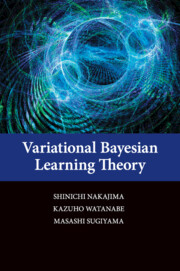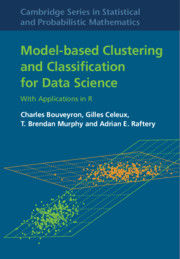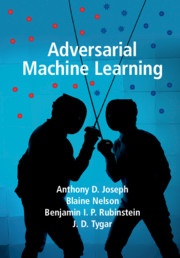Refine listing
Actions for selected content:
1437 results in Ebooks in machine learning
Appendix D - Optimality of Bayesian Learning
-
- Book:
- Variational Bayesian Learning Theory
- Published online:
- 24 June 2019
- Print publication:
- 11 July 2019, pp 527-528
-
- Chapter
- Export citation
Appendix C - Detailed Description of Overlap Method
-
- Book:
- Variational Bayesian Learning Theory
- Published online:
- 24 June 2019
- Print publication:
- 11 July 2019, pp 525-526
-
- Chapter
- Export citation
Preface
-
- Book:
- Model-Based Clustering and Classification for Data Science
- Published online:
- 14 June 2019
- Print publication:
- 11 July 2019, pp xv-xviii
-
- Chapter
- Export citation
Appendix A - James–Stein Estimator
-
- Book:
- Variational Bayesian Learning Theory
- Published online:
- 24 June 2019
- Print publication:
- 11 July 2019, pp 516-519
-
- Chapter
- Export citation
17 - Unified Theory for Latent Variable Models
- from Part IV - Asymptotic Theory
-
- Book:
- Variational Bayesian Learning Theory
- Published online:
- 24 June 2019
- Print publication:
- 11 July 2019, pp 500-515
-
- Chapter
- Export citation
10 - Global Solver for Low-Rank Subspace Clustering
- from Part III - Nonasymptotic Theory
-
- Book:
- Variational Bayesian Learning Theory
- Published online:
- 24 June 2019
- Print publication:
- 11 July 2019, pp 255-278
-
- Chapter
- Export citation
4 - Model-based Classification
-
- Book:
- Model-Based Clustering and Classification for Data Science
- Published online:
- 14 June 2019
- Print publication:
- 11 July 2019, pp 109-133
-
- Chapter
- Export citation
3 - Dealing with Difficulties
-
- Book:
- Model-Based Clustering and Classification for Data Science
- Published online:
- 14 June 2019
- Print publication:
- 11 July 2019, pp 79-108
-
- Chapter
- Export citation
Contents
-
- Book:
- Variational Bayesian Learning Theory
- Published online:
- 24 June 2019
- Print publication:
- 11 July 2019, pp v-viii
-
- Chapter
- Export citation

Variational Bayesian Learning Theory
-
- Published online:
- 24 June 2019
- Print publication:
- 11 July 2019

Model-Based Clustering and Classification for Data Science
- With Applications in R
-
- Published online:
- 14 June 2019
- Print publication:
- 11 July 2019

Adversarial Machine Learning
-
- Published online:
- 14 March 2019
- Print publication:
- 21 February 2019
6 - Markov Chain Monte Carlo Methods
-
- Book:
- Computational Bayesian Statistics
- Published online:
- 18 February 2019
- Print publication:
- 28 February 2019, pp 90-128
-
- Chapter
- Export citation
4 - Regression and Model Selection
- from Part II - Machine Learning and Data Analysis
-
- Book:
- Data-Driven Science and Engineering
- Published online:
- 15 February 2019
- Print publication:
- 28 February 2019, pp 117-153
-
- Chapter
- Export citation
5 - Clustering and Classification
- from Part II - Machine Learning and Data Analysis
-
- Book:
- Data-Driven Science and Engineering
- Published online:
- 15 February 2019
- Print publication:
- 28 February 2019, pp 154-194
-
- Chapter
- Export citation
Part IV - Reduced Order Models
-
- Book:
- Data-Driven Science and Engineering
- Published online:
- 15 February 2019
- Print publication:
- 28 February 2019, pp 373-374
-
- Chapter
- Export citation
Preface
-
- Book:
- Computational Bayesian Statistics
- Published online:
- 18 February 2019
- Print publication:
- 28 February 2019, pp ix-xii
-
- Chapter
- Export citation
Frontmatter
-
- Book:
- Data-Driven Science and Engineering
- Published online:
- 15 February 2019
- Print publication:
- 28 February 2019, pp i-iv
-
- Chapter
- Export citation
Preface to the English Version
-
- Book:
- Computational Bayesian Statistics
- Published online:
- 18 February 2019
- Print publication:
- 28 February 2019, pp viii-viii
-
- Chapter
- Export citation
11 - Reduced Order Models (ROMs)
- from Part IV - Reduced Order Models
-
- Book:
- Data-Driven Science and Engineering
- Published online:
- 15 February 2019
- Print publication:
- 28 February 2019, pp 375-402
-
- Chapter
- Export citation
